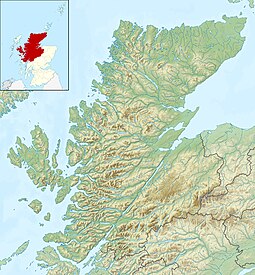Eilean Aigas
| Gaelic name | Eilean Àigeis |
|---|---|
| Location | |
|
Eilean Aigas shown within Highland Scotland
|
|
| OS grid reference | NH467417 |
| Coordinates | 57°26′23″N 4°33′18″W / 57.43976°N 4.55505°W |
| Physical geography | |
| Highest elevation | 103 m |
| Administration | |
| Sovereign state | United Kingdom |
| Country | Scotland |
| Council area | Highland |
| Demographics | |
| Population | No estimate available |
Eilean Aigas (NH4641) (Scottish Gaelic: Eilean Àigeis,pronounced [elanˈaɡ̊ʲəʃ]) is an island in the River Beauly, Scotland, in Kiltarlity parish in traditional Inverness-shire, now Highland Region. It is most notable for the mansion on it at its north end, which was formerly owned by the Sobieski Stuarts and rented by author and Scottish nationalist Compton Mackenzie from Lord Fraser of Lovat. It is joined to the bank by a narrow white bridge.
The Eilean Aigas estate was owned by the Lovat Frasers until 1995, when it was bought by King Chong Chai, a Malaysian businessman, for around £600,000. Chai put the island up for sale in 2001, for an asking price of £3 million. It was purchased by Brendan Clouston, a Canadian businessman, who was formerly president of Tele-Communications Inc.. The house was built in 2006, it is a replica of a 19th-century hunting lodge. In 2013 the estate was once again for sale, for offers over £15 million. It sold in 2015 for £3 million.
John Sobieski Stuart and Charles Edward Stuart were names used by John Carter Allen and Charles Manning Allen, two 19th-century English brothers who are best known for their role in Scottish cultural history. The Sobieski Stuarts were frauds, who claimed to descendants of Charles Edward Stuart. As authors of a dubious book on Scottish tartans and clan dress, the Vestiarium Scoticum, they are the source of some current tartan traditions.
In the 1830s they moved to Eilean Aigas into a hunting lodge granted them by the Earl of Lovat. Here they "held court" and surrounded themselves with royal paraphernalia: pennants, seals, even thrones. During their time here, they adopted the final version of their names, using the surname 'Stuart', and became practising Roman Catholics.
...
Wikipedia

